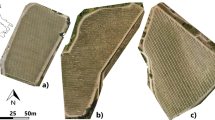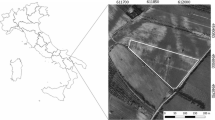Abstract
The wine industry needs to know the yield of each vine field precisely to optimize quality management and limit the costs of harvest operations. Yield estimation is usually based on random vine sampling. The resulting estimations are often not precise enough because of the high variability within vineyard fields. The aim of the work was to study the relevance of using NDVI-based sampling strategies to improve estimation of mean field yield. The study was conducted in nine non-irrigated vine fields located in southern France. For each field, NDVI was derived from multi-spectral airborne images. The variables which define the yield: [berry weight at harvest (BWh), bunch number per vine (BuN) and berry number per bunch (BN)] were measured on a regular grid. This data-base allowed for five different sampling schemes to be tested. These sampling methods were mainly based on a stratification of NDVI values, they differed in the way as to whether NDVI was used as ancillary information to design a sampling strategy for BuN, BN, BW or for all yield variables together. Results showed a significant linear relationship between NDVI and BW, indicating the interest of using NDVI information to optimize sampling for this parameter. However this result is mitigated by the low incidence of BW in the yield variance (4 %) within the field. Other yield components, BuN and BN explain a higher percentage of yield variance (60 and 11 % respectively) but did not show any clear relationship with NDVI. A large difference was observed between fields, which justifies testing the optimized sampling methods on all of them and for all yield variables. On average, sampling methods based on NDVI systematically improved vine field yield estimates by at least 5–7 % compared to the random method. Depending on the fields, error improvement ranged from −2 to 15 %. Based on these results, the practical recommendation is to consider a two-step sampling method where BuN is randomly sampled and BW is sampled according to the NDVI values.




Similar content being viewed by others
References
Acevedo-Opazo, C., Tisseyre, B., Guillaume, S., & Ojeda, H. (2008). The potential of high spatial resolution information to define within-vineyard zones related to vine water status. Precision Agriculture, 9(5), 285–302.
Baldwin, J. (1964). The relation between weather and fruitfulness of the sultana vine. Australian Journal of Agricultural Research, 15, 920–928.
Blom, P. E., & Tarara, J. M. (2009). Trellis tension monitoring improves yield estimation in vineyards. HortScience, 44(3), 678–685.
Bramley, R. G. V., Proffitt, A. P. B., Hinze, C. J., Pearse, B., & Hamilton, R. P. (2005). Generating benefits from precision viticulture through differential harvest. In J. V. Stafford (Ed.), Proceedings of the 5th European Conference on Precision Agriculture (pp. 891–898). Wageningen: Wageningen Academic Publishers.
Carbonneau, A., & Ollat, N. (1993). Etude de la coulure et maîtrise de la production (study on vines shattering and yield control). Progrès Agricole et Viticole, 110(15–16), 331–340.
Champagnol, F. (1984). Elements of the physiology of the vine and of general viticulture. Montpellier: Impr: Déhan.
Clingeleffer, P. R., Martin, S., Krstic, M., & Dunn, G. M. (2001). Crop development, crop estimation and crop control to secure quality and production of major wine grape varieties. A National Approach: Final Report to Grape and Wine Research & Development Corporation. Grape and Wine Research & Development Corporation (Victoria: CSIRO and NRE)
Coulouma, G., Tisseyre, B., & Lagacherie, P. (2010). Is a systematic two dimensional EMI soil survey always relevant for vineyard production management? A test on two pedologically contrasting Mediterranean vineyards (Chap. 24). In: R. A. Viscarra-Rossel, A. B. McBratney, & B. Minasny (Eds.), Proximal soil sensing. Progress in soil science series. Heidelburg: Springer. ISBN 978-90-481-8858-1.
Cristofolini, F., & Gottardini, E. (2000). Concentration of airborne pollen of Vitisvinifera L. and yield forecast: a case study at S.Michele all’Adige, Trento, Italy. Aerobiologia, 16, 171–216.
Diago, M. P., Correa, C., Millán, B., Barreiro, P., Valero, C., & Tardaguila, J. (2012). Grapevine yield and leaf area estimation using supervised classification methodology on RGB images taken under field conditions. Sensors, 12, 16988–17006.
Dunn, G. M., & Martin, S. R. (2004). Yield prediction from digital image analysis: A technique with potential for vineyard assessments prior to harvest. Australian Journal of Grape and Wine Research, 10, 196–198.
Efron, B. (1979). Bootstrap methods: another look at the jackknife. The annals of Statistics, 7(1), 1–26.
Grocholsky B., Nuske S., Aasted M., Achar S., & Bates T. (2011). A Camera and Laser System for Automatic Vine Balance Assessment. ASABE Technical Library, Paper no. 11-11651, ASABE, St Joseph, MI.
Hall, A., Lamb, D. W., Holzapfel, B. P., & Louis, J. P. (2011). Within-season temporal variation in correlations between vineyard canopy and winegrape composition and yield. Precision Agriculture, 12(1), 103–117.
Hengl, T., Gruber, S., & Shrestha, D. (2003). Digital terrain analysis in ILWIS. Lecture notes: International Institute for Geo-Information Science and Earth Observation (ITC) Enschede, The Netherlands. Retrieved April 22, 2015 https://www.itc.nl/library/Papers_2003/misca/hengl_digital.pdf.
Kazmierski, M., Glemas, P., Rousseau, J., & Tisseyre, B. (2011). Temporal stability of within-field patterns of NDVI in non irrigated Mediterranean vineyards. Journal International des Sciences de la Vigne et du vin, 45(2), 61–73.
Lamb, D. W., Weedon, M., & Bramley, R. (2004). Using remote sensing to predict grape phenolics and colour at harvest in a Cabernet Sauvignon vineyard: Timing observations against vine phenology and optimising image resolution. Australian Journal of Grape and Wine Research, 10(1), 46–54.
Lesch, S. (2005). Sensor-directed response surface sampling designs for characterizing spatial variation in soil properties. Computers and Electronics in Agriculture, 46(1–3), 153–179.
Lesch, S. M., Strauss, D. J., & Rhoades, J. D. (1995). Spatial prediction of soil salinity using electromagnetic induction techniques: 1. Statistical prediction models: A comparison of multiple linear regression and cokriging. Water Resources Research, 31(2), 373–386.
Martinez-Casasnovas, J. A., & Bordes, X. (2005). Viticultura de precisión: predicción de cosecha a partir de variables del cultivo e índices de vegetación (Precision viticulture: yield prediction from crop variables and vegetation indices). Revista de la Asociación Española de Teledetección, 24, 67–71.
Meyers, J. M., Sacks, G. L., van Es, H. M., & Vanden Heuvel, J. E. (2011). Improving vineyard sampling efficiency via dynamic spatially-explicit optimisation. Australian Journal of Grape and Wine Research, 17, 306–315.
Nuske, S., Achar, S., Bates, T., Narasimhan, S., & Singh, S. (2011). Yield estimation in vineyards by visual grape detection. In IEEE/RSJ International Conference on Intelligent Robots and Systems (IROS 2011) (pp. 2352–2358). doi:10.1109/iros.2011.6048830.
Rabatel, G. & Guizard, C. (2007). Grape berry calibration by computer vision using elliptical model fitting. In J. V. Stafford (Ed.) Precision Agriculture ‘07, Proceedings of the 6th European Conference on Precision Agriculture (pp. 581–587). Wageningen: Wageningen Academic Publishers.
Reis, M. J. C. S., Morais, R., Peres, E., Pereira, C., Contente, O., & Soares, S. (2012). Automatic detection of bunches of grapes in natural environment from color images. Journal of Applied Logic, 10, 285–290.
Robbez-Masson, J. M., & Foltete, J. C. (2005). Localising missing plants in squared grid patterns of discontinuous crops from remotely sensed imagery. Computers & Geosciences, 31, 900–912.
Rouse, J. W., Haas, R. H., Schell, J. A., & Deering, D. W. (1973). Monitoring vegetation systems in the great plains with ERTS. In S. C. Freden & M. A. Becker (Eds.), Third ERTS Symposium (pp. 309–317). Greenbelt, MD: NASA Goddard Space Flight Center.
Rousseau, J., Dupin, S., Acevedo-Opazo, C., Tisseyre, B., & Ojeda, H. (2008). L’imagerie aérienne: application à la caractérisation des potentiels viticoles et oenologiques [Airborne imagery: application to the characterization of viticultural and oenological potential]. Bulletin de l’organisation internationale de la vigne et du vin, 81, 507–517.
Rousseau, J., Pic, L., Carbonneau, A., & Ojeda, H. (2013). Incidence of minimal pruning on wine quality. Acta Horticolturae. (ISHS), 978, 309–316.
Santesteban, L., Guillaume, S., Royo, J., & Tisseyre, B. (2013). Are precision agriculture tools and methods relevant at the whole-vineyard scale? Precision Agriculture, 14(1), 2–17.
Scholander, P. F., Bradstreet, E. D., Hemmingsen, E., & Hammel, H. (1965). Sap pressure in vascular plants negative hydrostatic pressure can be measured in plants. Science, 148(3668), 339–346.
Serrano, E.; Roussel S., Gontier L., Dufourcq T. (2005). Estimation précoce du rendement de la vigne: corrélation entre le volume de la grappe de vitis vinifera en cours de croissance et son poids à la récolte (Early grape yield estimation: correlation between the volume of the cluster of vitis vinifera during growth and harvest weight), In: H. Schultz (Ed.) Proceeding of the Groupe Européen d’Etude des Systémes de Conduite de la Vigne, Geisenheim (pp. 311–318).
Sobol, I. M. (1993). Sensitivity estimates for nonlinear mathematical models. Mathematical Modelling and Computational Experiments, 1(4), 407–414.
Stein, A., & Ettema, C. (2003). An overview of spatial sampling procedures and experimental design of spatial studies for ecosystem comparisons. Agriculture, Ecosystems & Environment, 94, 31–47.
Taylor, J., Acevedo-Opazo, C., Ojeda, H., & Tisseyre, B. (2010). Identification and significance of sources of spatial variation in grapevine water status. Australian Journal of Grape and Wine Research, 16(1), 218–226.
Taylor, J., Tisseyre, B., Bramley, R., Reid, A. (2005). A comparison of the spatial variability of vineyard yield in European and Australian production systems. In J. V. Stafford (Ed.) Precision Agriculture ‘05, Proceedings of the 5th European Conference on Precision Agriculture (pp. 907–914). Wageningen: Wageningen Academic Publishers.
Wolpert, J., & Vilas, E. (1992). Estimating vineyard yields: Introduction to a simple, two-step method. American Journal of Enology and Viticulture, 43(4), 384–388.
Wulfsohn, D., Aravena-Zamora, F., Potin-Téllez, C., Zamora, I., & García-Fiñana, M. (2012). Multilevel systematic sampling to estimate total fruit number for yield forecasts. Precision Agriculture, 13(2), 256–275.
Acknowledgments
We gratefully acknowledge the Experimental station of Pech-Rouge (INRA). This work was funded by the EC, French Government, BPI France, Région Languedoc-Roussillon, through Vinnotec project (Qualimed Pole of Languedoc-Roussillon region—France).
Author information
Authors and Affiliations
Corresponding author
Rights and permissions
About this article
Cite this article
Carrillo, E., Matese, A., Rousseau, J. et al. Use of multi-spectral airborne imagery to improve yield sampling in viticulture. Precision Agric 17, 74–92 (2016). https://doi.org/10.1007/s11119-015-9407-8
Published:
Issue Date:
DOI: https://doi.org/10.1007/s11119-015-9407-8




